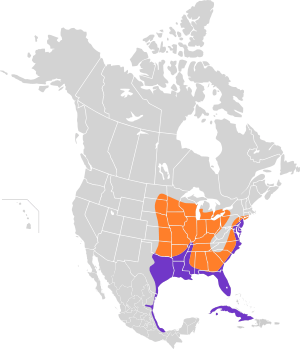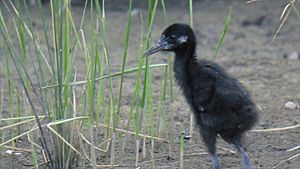King rail facts for kids
Quick facts for kids King rail |
|
|---|---|
 |
|
| Conservation status | |
| Scientific classification | |
| Genus: |
Rallus
|
| Species: |
elegans
|
 |
|
The king rail (Rallus elegans) is a fascinating waterbird. It's the biggest type of rail bird found in North America. These birds are known for living in wet, marshy areas.
Description

The king rail has a long bill that curves slightly downwards. Adult birds have a brown back and a rusty-brown color on their face and chest. They also have a dark brown cap on their head, a white throat, and a light belly with striped sides. Young king rails are covered in soft down feathers. They have light brown heads and darker brown backs and wings.
This bird's call is a low, repeated sound that sounds like kek-kek-kek.
Where They Live and Their Home
These birds build their nests in marshes across eastern North America. King rails living along the southeastern coasts of the United States stay in those areas all year round. Other king rails migrate to the southern United States and Mexico when the weather gets cold. In Canada, you can find them in southern Ontario. After nesting, an adult king rail will lose all its feathers and cannot fly for almost a month.
Daily Life
King rails are active during the day. This is different from some of their smaller relatives, which are active at night.
Reproduction
The nest of a king rail is like a raised platform. It's built using plants from the marsh and has a canopy (a roof) over it. This canopy helps hide the eggs from predators that might be looking for them from above.
King rails sometimes breed with clapper rails in places where both types of birds live. Because of this, some scientists think they might actually be the same species.
A female king rail usually lays 6 to 14 eggs. These eggs are pale buff (a light yellowish-brown) with brown spots. They are about 41 millimeters (1.6 inches) long and 30 millimeters (1.2 inches) wide. Both the mother and father bird take turns sitting on the eggs to keep them warm. This incubation period lasts for 21 to 23 days. When the eggs hatch, the young chicks are covered in soft down and can leave the nest right away. However, they can't find food for themselves. Their parents feed them for up to six weeks after they hatch.
Feeding
King rails look for food in shallow water near plants that offer cover. They mainly eat aquatic insects and crustaceans (like small crabs or shrimp). They find food by poking their long bills into the mud while moving through the shallow water.
The parents feed their chicks small bugs and other tiny creatures. The adult bird transfers the food directly from its beak to the chick's beak. Male king rails will also bring food to the female during their courtship.
Status
These birds are still common in some coastal areas. However, the number of king rails living inland has gone down. This is mainly because of habitat loss, meaning their marsh homes are being destroyed.
- King rail species account at Neotropical Birds (Cornell Lab of Ornithology)
See also
In Spanish: Rascón elegante para niños



